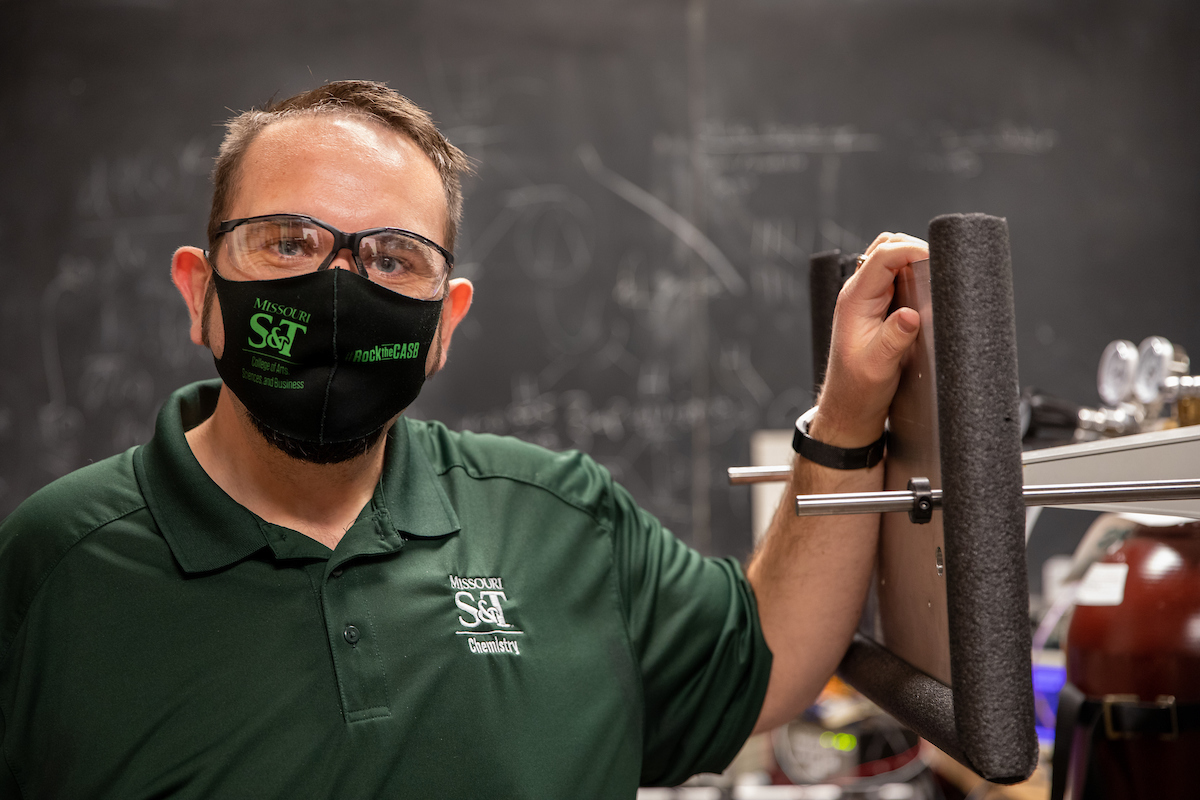Labs don’t stop for pandemics
Posted by Peter Ehrhard
On March 29, 2021

Garry Grubbs, associate professor of chemistry, didn’t let a pandemic stop him from teaching his laboratory courses.
When students returned to classes in the fall 2020, many courses moved to hybrid and remote learning due to social distancing requirements. For hands-on laboratory courses, this posed a question that the chemistry faculty were ready to answer after quickly developing ways to offer labs to all.
“To provide the best possible lab experience for students who could not physically be present, we offer livestreamed, real-time demonstrations of the scheduled lab experiments,” says Klaus Woelk, associate professor of chemistry. “Students are required to actively participate by naming compounds, balancing chemical equations and predicting outcomes of the experiments, as well as calculating masses, amounts and concentrations for the chemicals used.”
While a chemistry degree usually requires in-person lab experience, those requirements were waived due to the once-in-a-lifetime circumstances of the global pandemic.
“When COVID first hit, before online instruction was enacted, my graduate students and teaching assistants were aware that the switch may happen quickly so they took initiative to record all of our remaining physical chemistry laboratories in a two-day timeframe,” says Garry Grubbs, associate professor of chemistry. “The data was then shared with students and it allowed them to still observe how to arrive at the desired result while maintaining the mathematical and technical writing rigor associated with the course.”
For inorganic chemistry, displaying the detailed visual effects of reactions while explaining in real-time what was happening was a digital challenge.
“The inorganic chemistry lab is typically a very hands-on laboratory where students are required to synthesize compounds and observe reactions,” says Manashi Nath, associate professor of chemistry. “To make sure it was all captured, I ended up recording Zoom sessions where I conducted step-by-step protocols just like a student would, and my teaching assistant filmed close-up views of the reaction chambers. We would play the recording during class and I could offer additional explanations just like I would do during the regular in-person lab sessions.”
After passing through the crucible of teaching traditionally hands-on courses remotely, the faculty did learn a few tips and tricks for future remote teaching and learning.
“The number one piece of advice is to make sure the student is still engaged,” says Grubbs. “The added stresses of the pandemic can provide a pathway for them to lose interest or become disengaged. Becoming creative, while not also overcommitting yourself as the instructor is the key to the students maintaining the spirit of discovery.”
Nath echoes Grubbs’ advice to get students involved early and often.
“Lab courses are supposed to be hands-on experiences, and the hardest part of teaching lab remotely or socially distanced is just that — teaching lab remotely or socially distanced,” says Nath. “The trick that I tried was to put the “hands-on” component back in the virtual course platform. For example, in the pre-recorded videos I could pause and explain the action; that made the virtual lab more meaningful, and the students felt that they could get the most out of this lab, although they couldn’t perform all the experiments themselves.”
Posted by Peter Ehrhard
On March 29, 2021. Posted in Department of Chemistry, News
Looking for something?
Recent Posts
- Missouri S&T Mars Rover Design Team wins University Rover Challenge
- Missouri S&T Steel Bridge Design Team places fifth in national competition
- Ethanol: clean fuel, stronger economy – insights with S&T experts
- Missouri S&T students selected for travel grants from NSF
- S&T announces new Kummer Endowed Chair of Civil, Architectural and Environmental Engineering
Recent Comments
- John Stucker on Photo gallery: Spring 2025 Commencement
- Melissa baez on Traumatic brain injuries have toxic effects that last weeks after initial impact − an antioxidant material reduces this damage in mice
- Carl Frank Hansley on S&T atherosclerosis researcher awarded patent, says clinical trials ‘a few years away’
- lite14 on Kummer College launches new program
- Informatika on Missouri S&T choirs to perform spring concert
Upcoming events
Looking for something?
Recent Posts
- Missouri S&T Mars Rover Design Team wins University Rover Challenge
- Missouri S&T Steel Bridge Design Team places fifth in national competition
- Ethanol: clean fuel, stronger economy – insights with S&T experts
- Missouri S&T students selected for travel grants from NSF
- S&T announces new Kummer Endowed Chair of Civil, Architectural and Environmental Engineering
Recent Comments
- John Stucker on Photo gallery: Spring 2025 Commencement
- Melissa baez on Traumatic brain injuries have toxic effects that last weeks after initial impact − an antioxidant material reduces this damage in mice
- Carl Frank Hansley on S&T atherosclerosis researcher awarded patent, says clinical trials ‘a few years away’
- lite14 on Kummer College launches new program
- Informatika on Missouri S&T choirs to perform spring concert
Upcoming events
Missouri S&T is an equal opportunity employer
© 2025 - Curators of the University of Missouri | WordPress
Leave a Reply